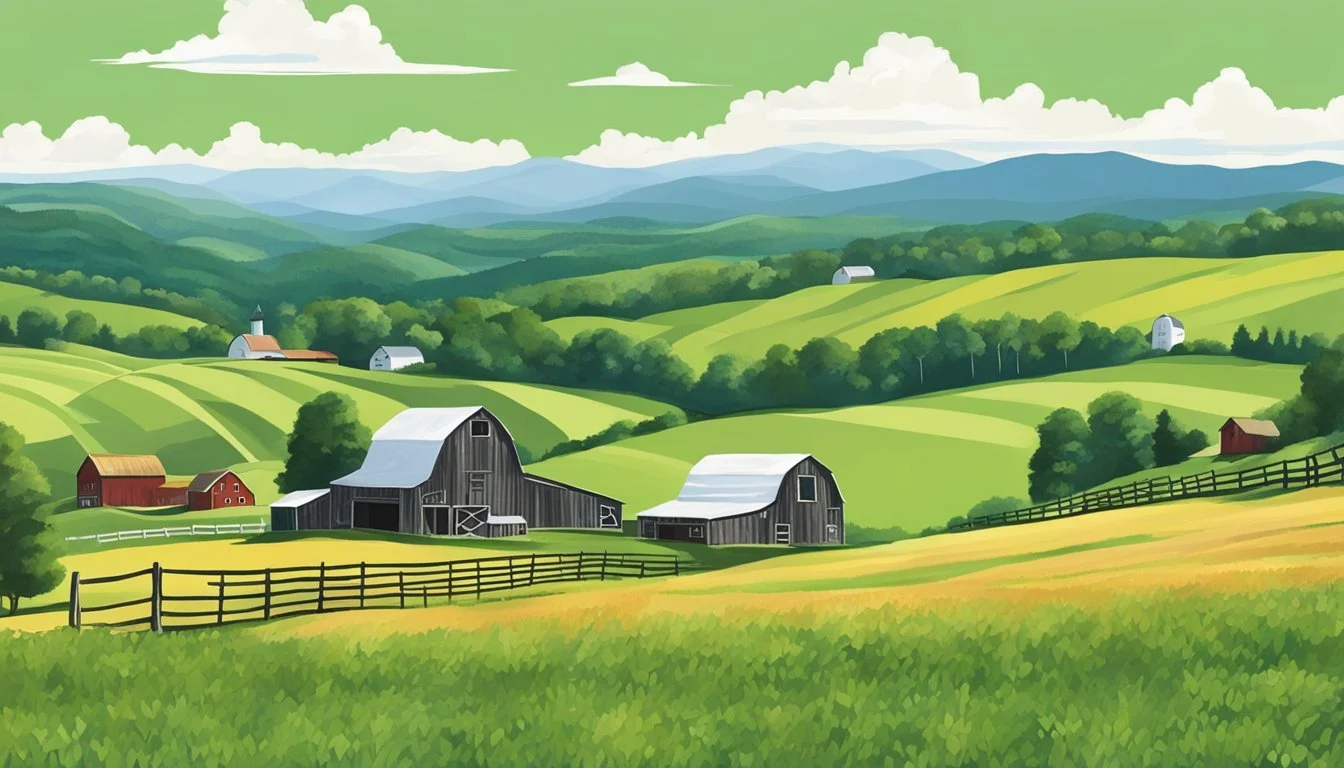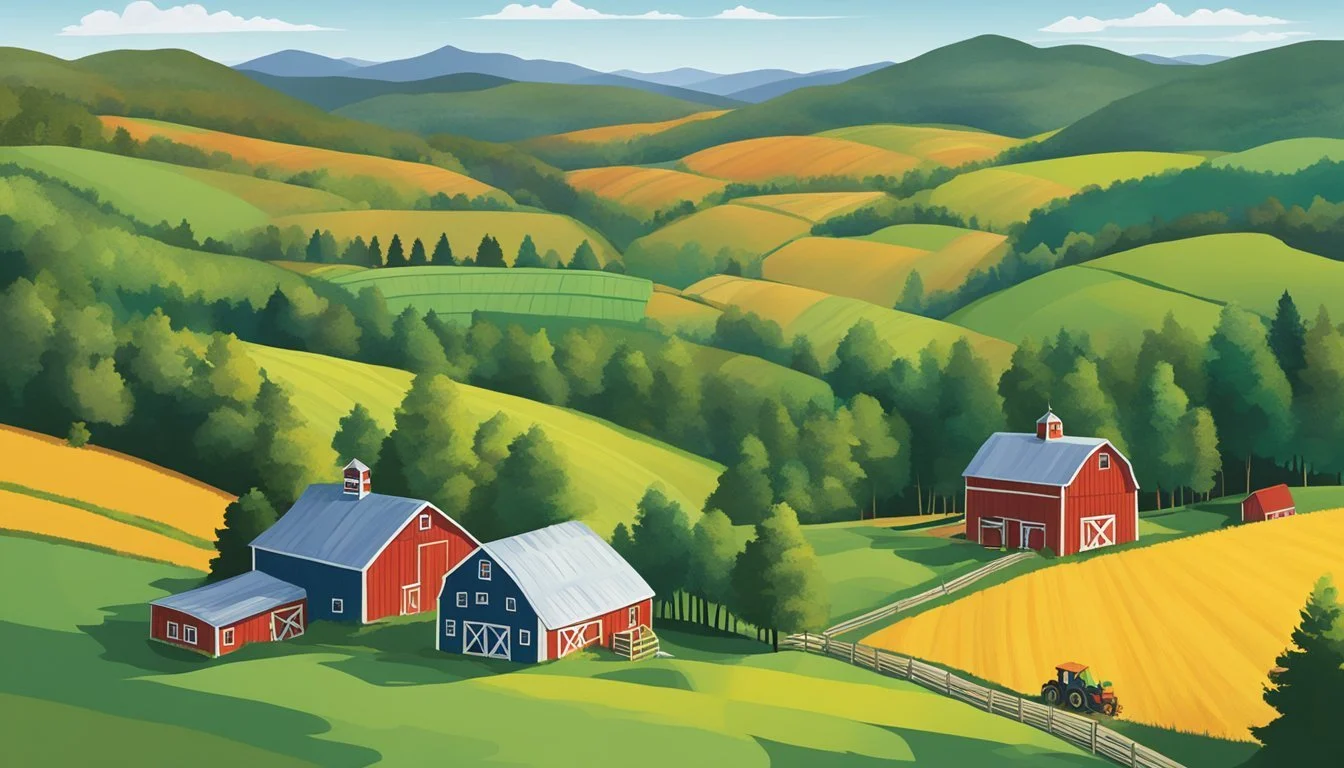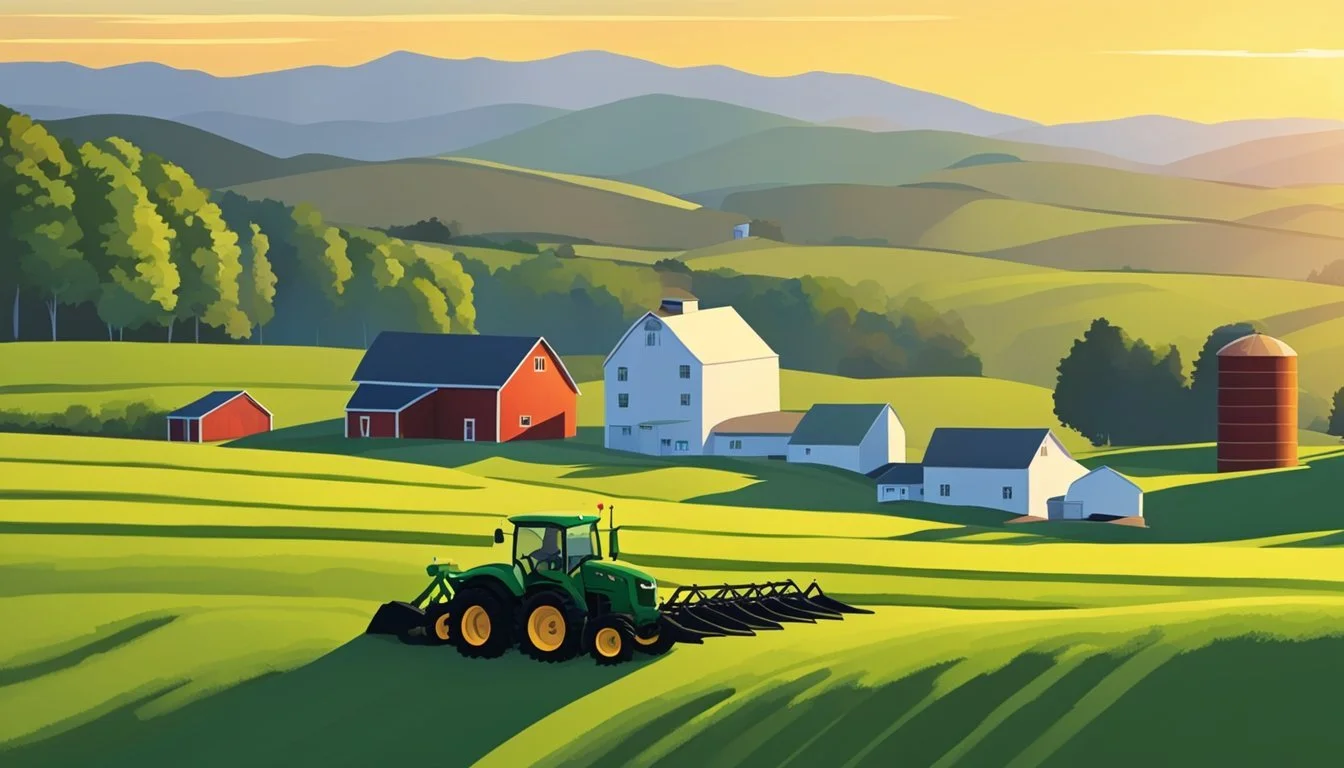Vermont Farm Land for Lease
Opportunities for Aspiring Agriculturists
This Article is Part of Our Guide on Navigating Agricultural Leases Across the US
Vermont, with its picturesque landscapes and fertile soils, offers a variety of opportunities for those interested in farming. The state's agricultural sector benefits from diverse farm land available for lease, catering to a range of farming activities from dairy and beef to hemp and organic crop production. Information on properties is accessible through a number of platforms, with details concerning acreage, permissible uses, and lease terms clearly outlined to aid potential lessees in making informed decisions.
Leasing farm land in Vermont provides a practical avenue for both established and aspiring farmers to embark on or expand their agricultural ventures without the significant upfront costs of purchasing property. A lease agreement typically outlines essential terms, including the duration of the lease, payment schedules, and rights to renewal, ensuring clarity and a mutual understanding between landowners and tenants.
As the trend toward local food production and sustainable agriculture grows, Vermont's available farm land for lease becomes increasingly attractive. The state's land link programs further facilitate connections between farmers and available land, ensuring that the valuable resource of tillable land is utilized effectively to support both the local economy and the environment.
Understanding Farmland Leasing in Vermont
When considering farmland leasing in Vermont, landowners and farmers must navigate various tenure arrangements, comprehend the critical terms and conditions, and adhere to legal frameworks to ensure mutually beneficial agreements.
Types of Tenure Arrangements
Leasing land to farmers in Vermont can take multiple forms. Common tenure arrangements include:
Year-to-Year Lease: An agreement that renews annually.
Multi-Year Lease: This arrangement spans several years without the need for annual renegotiation.
Rolling or Renewable Lease: Offers a renewal option that keeps the lease active beyond its initial term.
Lease with Option to Buy: Gives the farmer a right to purchase the land during or after the lease term.
Right of First Refusal: Allows the farmer to match any offer the landowner receives from another buyer.
These lease types provide various levels of security and flexibility for both the farmer and the landowner.
Important Terms and Conditions
Terms and conditions in a lease agreement are crucial to prevent future disputes. Essential terms include:
Rent Amount: Clearly defined, whether fixed or based on a percentage of the farm's revenues.
Payment Schedule: Must be outlined, typically annually or semi-annually.
Duration: The lease length should be stated explicitly.
Termination Clauses: Conditions under which either party may exit the agreement.
Land Use: The lease should specify what types of farming practices are permitted.
Each lease is a unique contract tailored to the needs of the farmer and the landowner involved.
Legal Considerations
The legal framework governing farmland leasing in Vermont includes:
Statutory Requirements: Vermont statutes may dictate certain aspects of the lease, especially regarding termination and renewals.
Liability Clauses: It's essential to agree on who is liable for injuries or property damage.
Compliance with Environmental Laws: Ensuring farming practices adhere to state and federal regulations is necessary.
Both parties should consult with legal experts to validate that the lease agreement complies with all pertinent laws and regulations, which protects the interests of the farmer and the landowner alike.
Searching for Vermont Farmland
When seeking agricultural land in Vermont, individuals should prioritize finding the right property, utilize Vermont Land Link, and consult the VT Natural Resources Atlas for comprehensive information.
Finding the Right Property
The journey to secure farmland in Vermont should begin with a clear evaluation of the desired property location and acreage needs. Prospective leasers should consider proximity to markets, the quality of soil, water sources, and existing infrastructures such as barns or greenhouses. They may use platforms like Google Maps to scrutinize the geography and access routes of potential listings.
Using Vermont Land Link
Vermont Land Link is a pivotal resource for connecting farmers with available land. The platform allows users to filter searches according to specific criteria, making it simpler to find properties that match their requirements. Here's how Vermont Land Link structures listings:
Location: Detailed property address
Acreage: Size of the plot
Price: Rental or purchase amounts
Infrastructure: Existing farming facilities, if any
Utilizing VT Natural Resources Atlas
For a more in-depth understanding of Vermont's farmland, the VT Natural Resources Atlas provides geographic information about natural resources, environmental features, and land cover. They offer an Atlas Tutorial to help users navigate the tool effectively. Key functions of the atlas include:
Land Analysis: Assess soil quality, elevation, and land use.
Environmental Data: Locate water bodies, floodplains, and protected areas.
Geographic Information: Access maps and comprehensive datasets for more informed decision-making.
Farmland Characteristics and Evaluation
When considering Vermont farmland for lease, one must carefully evaluate the land's potential by examining soil quality, water availability, and the distinction between agricultural and forested land. These features determine the land's suitability for various types of farming operations.
Soil Quality and Types
The soil quality of farmland is critical for agricultural success. Good soil should have a balance of clay, silt, and sand, which affects drainage and nutrient availability. High levels of organic matter usually indicate fertile soil that can support robust crop growth. Vermont's soils range from loamy—ideal for numerous crops—to clay-heavy soils that may pose challenges but can still be productive with proper management.
Water Sources and Irrigation
Access to reliable water sources is essential for farming. Farmland should be evaluated for its proximity to rivers, lakes, or underground aquifers. The presence of established irrigation systems or the potential for such systems to be installed will significantly affect the farming operations. Good drainage is also imperative to prevent waterlogging and ensure that crops get the optimal amount of moisture without risk of root diseases.
Agricultural and Forested Land
Leased land in Vermont may be a mix of open agricultural areas and forested land. Agricultural land is generally cleared and may have existing crop fields or pastures, which are suitable for immediate use or conversion to organic production. Forested land, on the other hand, can provide opportunities for sustainable timber, maple syrup harvesting, or conversion into additional cropland, depending on the lessee's goals. The quality and composition of the forest can also contribute to the overall biodiversity and health of the farm ecosystem.
Lease Agreement Essentials
When leasing farm land in Vermont, it is crucial to understand the essentials of a lease agreement to ensure clarity and avoid future disputes. Details such as duration, cost, responsibilities, and included resources are fundamental components of a successful lease.
Determining Lease Duration and Cost
Duration:
The lease should clearly state the commencement date and termination date.
Options to extend or renew the lease should be included if applicable.
Cost:
The rental amount must be explicitly stated.
The frequency of payments (e.g., monthly, quarterly) and the due dates should be clear.
Specify the location or method of payment (online, check, etc.).
Roles and Responsibilities of Parties
Both parties must have a clear understanding of their roles in the agreement:
Landowner:
Must ensure that the property is in a condition that's suitable for the agreed-upon use.
Should outline any restrictions or requirements on land use or farming practices.
Farmer:
Responsible for maintaining the property in good condition.
Expected to adhere to the agreed-upon uses of the land and not to overstep those boundaries.
Resources and Infrastructure Included
The lease must enumerate all resources and infrastructure that come with the property:
Land and Soil Quality: Specific acreage and the condition of the soil that's being leased.
Equipment: Any machinery and equipment provided should be listed and their condition noted.
Barns and Sheds: If structures such as barns and sheds are included, they should be described in detail.
Farmer Housing: In some cases, housing may be part of the lease. If included, details regarding the housing should be specified.
Utilities and Services: Clarify what is provided and what the tenant is responsible for, such as electricity or water.
Financial Considerations and Support
When leasing farm land in Vermont, financial considerations play a critical role, encompassing initial capital, ongoing operating expenses, funding opportunities, and the benefits of conservation easements on affordability and sustainability.
Estimating Capital and Operating Expenses
Calculating the startup and maintenance costs is essential for leasing farm land. Capital expenses may include purchasing equipment and machinery, essential for both conventional and organic farm operations. Operating expenses can encompass costs associated with fertilizing, seeding, labor, and utilities.
Equipment and Machinery: Tractors, plows, harvesters
Fertilize Expenses: Organic or synthetic fertilizers
Seed and Planting Costs: Vary depending on crop selection
Accessing Funds and Financial Assistance
Farmers can access various funds and grants designed to support agriculture. These funding sources may be directed towards land acquisition, enhancing markets, and purchasing necessary capital, or may support specific practices such as organic farming.
Federal Grants: For example, USDA programs offering financial support
State Programs: Vermont-specific grants and loans
Private Funds: Loans from agricultural lenders or investors
Conservation Easement Benefits
A conservation easement can make Vermont farm land more affordable by limiting development and preserving the land for agricultural use. These easements may increase the land's sustainability and appeal to markets interested in conservation-friendly products.
Reduced Purchase Price: Reflects the easement-imposed limitations
Tax Benefits: Potential for reduced property taxes
Sustainable Practice Support: Can attract customers and investors interested in eco-friendly farming
Preparing for Farming Operations
Before embarking on farming operations in Vermont, lessees must develop a comprehensive farming plan that includes organic practices and animal management strategies. This preparation ensures the farm's resources are used effectively and sustainably.
Developing a Farming Plan
A farming plan outlines the lessee’s intended use of the land and details how crops will be managed. It should include a crop rotation schedule, soil management practices such as tillage or no-till methods, and detailed financial projections. This plan acts as a blueprint for the farming operations and can be essential to securing leases and investments.
Crop Rotation Schedule: Involves planting different crops sequentially to manage soil fertility and help prevent disease and pests.
Soil Management: Choosing between traditional tillage or conservation methods impacts soil health and productivity.
Organic Farming Considerations
When the lessee aims to produce organic products, they must adhere to specific regulations and standards. The farm plan must include strategies for maintaining soil fertility and pest control without synthetic chemicals.
Organic Certification: Farms must be certified by an accredited organization to market their products as "organic"
Resource Management: Proper management of water, soil, and biodiversity is crucial in organic farming systems
Livestock and Animal Management
For those who intend to establish an organic dairy farm or other livestock operations, animal management plays a critical role. It involves housing, feed, health care, and handling practices that align with organic standards and promote animal welfare.
Feed: Organic livestock must have access to certified organic feed, and grazing on organic pastures is required.
Healthcare: Disease prevention strategies, sanitation, and veterinary care should minimize the need for medical interventions.
Lessee's commitment to a well-structured farming plan, attentive organic farming practices, and humane animal management will contribute to the overall success and sustainability of the farm operations.
Marketing and Selling Farm Produce
When Vermont farmers look to lease farmland, they should not only consider the quality of the land but also the viability of marketing and selling their produce. The development of a sustainable business model and identification of local markets are critical steps in ensuring the success of farm produce sales.
Identifying Local Markets and Opportunities
Farmers should assess the local markets to determine what products are in demand. They can visit farmers markets, engage with local food co-ops, and participate in community-supported agriculture (CSA) programs to better understand the needs of the community. It's essential to establish connections with restaurants and grocery stores that prioritize sourcing locally. Providing unique offerings, such as heirloom vegetables or organic products, can also set a farm apart in competitive markets.
One effective way to pinpoint opportunities is to leverage:
Agricultural extensions: These services often have resources and experts who can help farmers find local market trends.
Local Market Surveys: Gleaning information on consumer preferences within specific areas.
Networking: Attending agricultural events to build relationships with other farmers and buyers.
Creating a Sustainable Business Model
Creating a sustainable business model requires farmers to balance production costs with potential revenue streams. They should calculate the costs of leasing, equipment, seeds, labor, and infrastructure against the expected market price of their goods. Diversification of crops and products can mitigate risk and attract a broader customer base.
Farmers should consider the following aspects:
Cost Management: Keeping overheads low while ensuring quality.
Marketing Strategy: Developing a strong brand and online presence using digital platforms to promote products.
Value-Added Services: Offering delivery, u-pick opportunities, or farm tours.
Funding: Exploring grant programs or loans tailored for agricultural enterprises.
By focusing on these key areas, farmers can increase their chances of running profitable operations that effectively market and sell farm produce in Vermont.
Living on the Farm
For those seeking a lifestyle immersed in agriculture, living on a farm in Vermont can offer a blend of hard work and homely living spaces set against the backdrop of the state's natural beauty.
Housing and Amenities for Farm Families
Farmhouses in Vermont often combine rustic charm with functional living areas. A typical listing may feature a historically significant colonial house or a modernized farmhouse with various amenities to cater to farm families. For example, a property posted on Vermont Land Link includes a farmhouse on 38 acres, offering ample space for both farming and family life. The house may have multiple bedrooms, necessary for comfortable living, and can range from quaint, older constructions to newer builds with updated facilities.
Typical Housing Features:
Bedrooms: Varies, can be upwards of 4 bedrooms.
Amenities: Depending on the real estate listing, amenities may include modern kitchens, large common areas, storage facilities, and sometimes even office spaces which are beneficial for managing the farm business.
Balancing Work and Personal Life
The experience of living on a farm is unique, marked by the overlapping domains of work and personal life. Structures often serve dual purposes; for instance, a barn may offer storage for farming equipment while also housing recreational areas. The challenge for farming families lies in striking a balance where the boundaries between farm work and home life are respected. This balance can make for a rewarding experience, as the rhythm of life flows with the demands of the seasons and agricultural cycles.
Elements of Work-Life Balance:
Work Domain: Access to greenhouses, fields, and barns for efficient farm management.
Personal Domain: Private spaces within the house and farm that allow for rest and family time, separate from the workspace.
Access to real-world experiences on a working farm can be deeply enriching but requires careful consideration of the integration of work and family areas to maintain a healthy balance.
Case Studies and Success Stories
In Vermont, successful lease arrangements and the experiences of seasoned farmers offer valuable insights and models for contemporary and prospective farmers seeking land.
Highlighting Successful Leases
Blue House Farm and Meridian Orchards serve as prominent examples of effective leasing agreements. In the case of Blue House Farm, the use of a rolling lease — a flexible agreement that adapts over time — has been instrumental. Meanwhile, Meridian Orchards has harnessed federal conservation programs to create a sustainable farming operation. Both cases reflect how tailored leasing strategies can be applied to foster long-term agricultural success and land stewardship within the community.
Learning from Experienced Farmers
The Vermont Land Trust has been pivotal in connecting farmers with the land. It facilitates discussions and knowledge sharing among farmers, helping those new to the field gain experience and offering current landowners examples of viable leasing models. Through the Vermont Land Trust’s networks, farmers seeking land receive support including connections to landowners and access to resources, guiding successful land transfers and ensuring the land's continued agricultural use benefits the public interest.
Additional Resources for Prospective Tenants
When exploring farmland leasing options in Vermont, a vast array of resources are available to prospective tenants that can assist them in making informed decisions.
Available Listings and Contacts:
Intervale Center: Offers access to farming opportunities and can play a crucial role in connecting farmers with land for rent in Vermont.
Land for Rent in Vermont Listings: Often found through local agricultural networks and rural estate agencies, these listings provide up-to-date availability for those seeking to lease.
Information and Guidance:
Farm Family Assistance: Organizations such as local Cooperative Extension offices provide advice and workshops aimed at both established and aspiring farm families.
Conservation Relations: Understanding local conservation efforts and easements is critical – Vermont's Agency of Agriculture can offer guidance on land use restrictions and conservation practices.
Leasing Kits and Templates:
The Farmland Access Legal Toolkit provides downloadable resources for drafting leasing agreements tailored to tenant's and landowner's needs.
Educational References:
Lease Agreements Guides: In-depth guides and comparison tools can be found through the University of Vermont Extension – a vital reference for legal and practical advice on farmland leasing.
Webinars and Workshops: Educational institutions and agricultural organizations in Vermont periodically host events that offer networking opportunities and share comprehensive content on agricultural practices.
It is essential for prospective tenants to utilize these resources to secure land that meets their specific farming goals and to ensure a successful tenancy.










